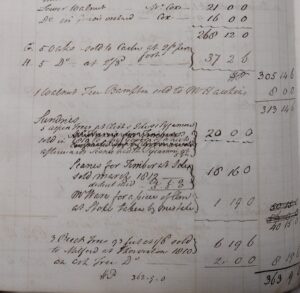 By Ellie Jones, Cathedral Archivist
By Ellie Jones, Cathedral Archivist
For some of us, tree-spotting is a year-round pastime, but what better time could there be for more of us to pause and think about trees than National Tree Week (22-30 November)? Run by the Tree Council, it is “the UK’s largest annual tree celebration, marking the start of the winter tree planting season”. The festival is now in its 50th year and events will be taking place in woodlands, libraries and elsewhere across the country – including the Cathedral Library & Archives.
Trees have provided many of the ingredients used to make the documents in the collections – the pages, the bindings, and even the inks – but the records also contain valuable information about how trees were planted, grown, pruned, felled and otherwise managed historically across the Dean & Chapter’s estates. Alder, ash, aspen, beech, birch, elm, fir, linden, oak, poplar, sycamore, and walnut are some of the tree species which turn up in the records in the Cathedral Library & Archives.
The Cathedral Library has a copy of the influential 17th century forestry text, John Evelyn’s ‘Sylva, or A Discourse of Forest-Trees and the Propagation of Timber in His Majesty’s Dominions’ (1670) which discusses forestry management linked to the production of timbers for the building of naval vessels. The Cathedral Archives contains numerous tree-related records such as: an 11th century document featuring a great linden tree used as a boundary marker, vivid descriptions of the ornamental planting of an avenue of pleached elms on Cathedral Green in the 18th century, insightful reports on the planting of new larch plantations at Stoke Woods in the 1820s, and a useful set of 19th century timber accounts.
Historically, trees were an extremely important source of revenue for the Dean & Chapter, the timbers they produced provided income, fuel, and valuable building materials, and live trees were sometimes transplanted between properties or onto Cathedral Green to replace dead or dying specimens. The account books of the Timber Fund provide a wealth of information about the commercial management of trees. The page shown here is part of an account of timber sales from 1812 which tells us about the sale of oaks, elms and walnuts from Bampton (Oxfordshire), beech from Thorverton, aspen and sycamore at Clyst, and a fine received from Mr Ware for “a piece of elm taken at Stoke by mistake”. A lot of trees were felled “by mistake” and the Dean & Chapter levied fines on those who illegally felled trees on their estates.
This month’s In Focus is a pop-up exhibition about trees as they appear in the Cathedral Library & Archives’ collections. Click here to find out more.